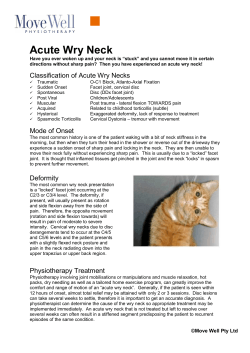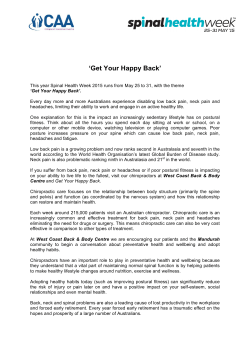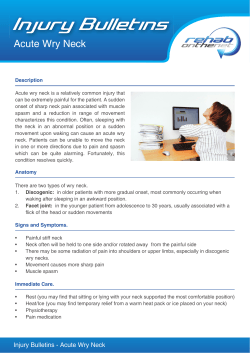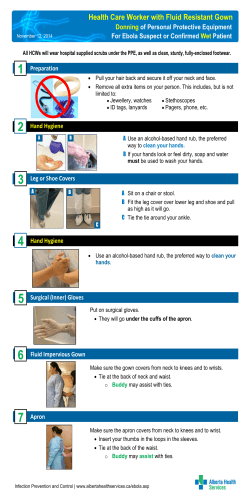
PDF - Fenton Fitness
Fenton Physical Therapy Brain Safe Preventing Concussions With Proper Training This book is available for download on our website at www.fentonphysicaltherapy.com Michael S. O’Hara, P.T., OCS, CSCS Fenton Physical Therapy 400 Rounds Drive Fenton, MI 48430 810-750-1996 www.fentonphysicaltherapy.com Visit our blog at: www.mikeoharapt.com Fenton Fitness & Athletic Center 404 Rounds Drive Fenton, MI 48430 810-750-0351 www.fentonfitness.com Copyright 2014-Fenton Physical Therapy Video demonstration of the exercises found in this book can be viewed on our youtube channel at: http://youtu.be/1XrfJXZ8Fjo BRAIN SAFE Preventing Concussions With Proper Training In 2004, many physical therapists, trainers, strength coaches, and physicians did not believe we could lower the incidence of anterior cruciate (ACL) injuries in athletes with a targeted exercise protocol. Ten years later, ACL injury prevention programs have been instrumental in dramatically reducing ACL injuries. Today, the biggest injury concern athletes, parents, and coaches face is a concussion. The question many of us have is: Can we reduce the number of sports related concussions with proper exercise? While the results of ongoing research are still in process, the preliminary findings show promise. I do not think it is unwise to begin a concussion prevention training program before the results of all the double blind, peer reviewed studies are published. I am reasonably sure the results will show that a program of neck strengthening exercises can reduce the incidence of concussions. Most people think a concussion is brought on by a direct blow to the head. Skull impact traumas do cause concussions, but they are not the most common cause. The majority of concussions are caused when the brain moves violently back and forth inside the skull. The brain gets bruised when it impacts the inner surface of the skull. Biomechanical force studies on anthropometrically equivalent “model necks” and skulls have demonstrated that a stiffer neck resulted in less force being delivered to the contents of the skull. If an athlete’s neck muscles are stronger, more coordinated, and able to efficiently decelerate force, then it is reasonable to assume that the neck will be stiffer and the brain better protected. This past February, Dawn Comstock, an associate professor at the Colorado School of Public Health, presented the findings of a pilot study on concussion incidence rates and neck strength. Data was collected on 6,704 athletes nationwide in three sports; girls’ and boys’ soccer, lacrosse, and basketball. Before the competitive seasons began, they measured neck length, head size, neck circumference, and neck strength. The concussion incidence was tracked over the course of next two years. After adjusting for gender and sport, overall neck strength remained a statistically significant predictor of concussion. For every one pound of increase in neck strength the odds of concussion fell by 5%. BRAIN SAFE TRAINING PROGRAM The exercises we use in this program are simple and take less than ten minutes to perform. The program should be made a part of formal practice with the coach leading the athletes through the exercises. Four of the exercises require no equipment and can be performed on the practice field. The other four are performed in the weight room with basic strength training tools. This program is best suited for younger athletes involved in hockey, football, soccer, lacrosse, basketball, or little league. Athletes involved in more aggressive impact sports with larger opponents such as high school or collegiate football, boxing, wrestling, and mixed martial arts will have to progress to higher level strengthening exercises and a much more developed neck. All of the exercises in this program involve isometric muscle contractions to strengthen the neck. Isometrics are more effective at targeting the deep cervical muscles. Isometrics are easy to teach in a team format and will be less likely to create the muscle hypertrophy that concerns many female athletes. Michael S. O’Hara, P.T., OCS, CSCS 400 Rounds Drive Fenton Physical Therapy Fenton, MI 48430 810-750-1996 www.fentonphysicaltherapy.com Field Exercises Injury prevention is important, so it must be done every day. These four drills are performed before a practice session on the field, court, or in the gym. They take less than ten minutes to complete, and after a few sessions, most teams will be independent in the drills and require less monitoring. Axial Extension Posture Correction The rounded shoulder, forward head posture has become more prevalent as the time spent on video games and facebook has increased. Young athletes often need to be instructed on a “tight and tall” cervical and upper back posture. Your neck muscles cannot work efficiently if they are constantly held in an abnormal position. Have the athletes stand with a “proud chest” and place the hands on the chest “like a praying angel”. The fingertips should touch the front of the chin. Keep the hands still and pull the head back so the chin moves away from the fingers. Tell them to pretend that a string is attached to the crown of the head and it is being pulled up to make them taller. Hold the head back for three counts and then return to the starting position. Repeat for ten repetitions. 400 Rounds Drive Fenton Physical Therapy Fenton, MI 48430 810-750-1996 www.fentonphysicaltherapy.com Four Point Lateral Stabilization The cervical and shoulder girdle muscles work together as a team to help stabilize the neck. This exercise helps train the strength and coordination between these muscle groups. Teammates pair up to perform this drill. One athlete performs the exercise and the other assists by acting as the resistance. The athlete performing the drill assumes an “all fours position” with the knees under the hips and hands under the shoulders. They must maintain the shoulder blades down the back and the axial extended head position with the eyes looking down. The assisting teammate stands and places one leg directly adjacent to the side of the head. The athlete then contracts the neck muscles and holds an isometric contraction against the side of the teammate’s leg for ten seconds. The assistant then switches over to the other side of the head and repeats the exercise. Perform four or five repetitions on each side. The most common mistake is poor set up position. The shoulder blades must be tight to the back and neck long. The verbal cue of “pushing the hands into the ground” and “tightening the muscles in the armpits” often helps. 400 Rounds Drive Fenton Physical Therapy Fenton, MI 48430 810-750-1996 www.fentonphysicaltherapy.com Shoulder Taps The Shoulder Tap will develop better strength and deceleration capacity in the muscles that travel from the shoulders to the neck. The athlete will be better at getting the hands forward to absorb the impact of a fall. Get into a push up position with the shoulder blades locked down the back and the neck in an axial extended position. Place the feet shoulder width apart. Tighten up the gluteals and brace the abdominal muscles. Lift the left hand up and touch the right shoulder. Return the left hand to the starting position and repeat with the right arm. Alternate shoulder taps for ten to twelve repetitions. To make it more challenging, throw in a push up between every shoulder tap. Common mistakes are letting the shoulder blade pop up off the rib cage and/or permitting the head to fall forward. Cue the athlete to aggressively “push into the ground” and keep the neck long. 400 Rounds Drive Fenton Physical Therapy Fenton, MI 48430 810-750-1996 www.fentonphysicaltherapy.com Prone Head Lifts This exercise teaches the athlete how to move the cervical and thoracic spine joint segments as an integrated team. This movement pattern is often very weak and limited due to extended time in the slouched over position. Lay face down on the floor with the hands under the forehead. The palms are placed on the floor and the elbows out to the side. Pull the shoulder blades down the back and keep the neck long. Lift the head and arms up off the floor and hold for five seconds. Keep the gaze directed at the floor and do not look up. Lower slowly and repeat for eight to ten repetitions. The most common mistake is that the athlete will often extend the neck and look up. The head and neck must stay in a neutral position and lift up together with the upper thoracic spine. 400 Rounds Drive Fenton Physical Therapy Fenton, MI 48430 810-750-1996 www.fentonphysicaltherapy.com Weight Room Exercises These four drills are performed in the weight room. These exercises can be interspersed with the team’s other strength training activities. The only tools you need are a physioball and a kettlebell or dumbbell. They are more coaching intensive, and just like any strength training activity, they need to be monitored. Physioball Belly On Ball Touchdowns This exercise strengthens all of the posterior shoulder girdle and deep cervical muscle. It also helps train away the very common problem of over active upper trapezius muscles. The athletes position facedown with the belly on the physioball. You need a fairly firm ball that does not flatten out when placed under load. Lengthen the neck and thoracic spine They should not move at all during the exercise. Keep the gluteal muscles tight and legs extended. Start with the arm in front of the shoulders on either side of the ball. The shoulders should be externally rotated, the hands in a “thumbs up” position. Raise the arms overhead like a football official signaling touchdown. This will create a Y shape with your torso and arms. Hold the arms overhead for three counts and then lower back down in a controlled fashion. Repeat for 10-12 repetitions. Common mistakes are using a ball that is too small or too soft, swinging the arms up and down instead of in a controlled fashion, failing to hold the arms overhead for three counts, extending the cervical spine or looking up, instead of maintaining a lengthened position through the spine. You can hold dumbbells to make the exercise more challenging. 400 Rounds Drive Fenton Physical Therapy Fenton, MI 48430 810-750-1996 www.fentonphysicaltherapy.com Physioball Ball On Wall Lateral Isometric Hold This series of four isometric neck exercises will help develop neck strength, proprioceptive awareness and better posture. You need a physioball and a wall to perform this drill. Stand so the left side of the body is parallel to a wall. Position a physioball on the wall at the same level as your forehead. Place the left side of your head on the ball while maintaining a tight and tall upright posture. Gently contract the neck muscles and push the head against the ball for ten seconds. Rest for ten seconds and repeat. Maintain a tall posture and keep the shoulders down while focusing on maintaining a steady pressure on the ball. Perform five isometric holds on each side of the head. Common mistakes are setting up with the neck bent sideways or forward. The head and neck must be upright and straight. Pushing too hard. Focus on creating a steady and sustained contraction in the neck muscles. As you become more proficient, hold the contraction for longer periods of time. Shrugging the shoulders. Keep the shoulder muscles relaxed. Clenching the jaw. Keep the jaw muscles relaxed. 400 Rounds Drive Fenton Physical Therapy Fenton, MI 48430 810-750-1996 www.fentonphysicaltherapy.com Physioball Neck Bridges This is the most challenging exercise in this program. Perform all of the other exercises for at least a month before adding this drill. Provided the athlete is not too heavy, he or she should be able to progress to the physioball neck bridge. Position the upper back on the physioball with the feet on the floor. Taller athletes will use a 65 centimeter ball and shorter athletes a 55 centimeter ball. Use the legs to roll out on the ball so only the back of the head is resting on the ball. Keep the neck muscles tight and maintain a lengthened cervical spine. Do not allow the neck to bend. Hold for five to ten seconds and then rest for an equal amount of time. Repeat for five repetitions. The most common error is allowing the neck to bend and shrugging the shoulders up toward the neck. The height of the ball is important. Taller athletes must use a bigger ball. 400 Rounds Drive Fenton Physical Therapy Fenton, MI 48430 810-750-1996 www.fentonphysicaltherapy.com Suitcase Carry The muscles that run from the neck to the shoulder girdle and rib cage help stabilize the neck. The suitcase carry develops unilateral integrity of the neck and has the added benefit of being a great core stabilization drill. You will need a kettlebell or dumbbell and some open space to perform this drill. Hold the chosen implement (dumbbell or kettlebell) in the right hand. Grip the implement with authority. Stand tall with a “proud chest” and an axially extended cervical spine. Walk for twenty yards carrying the implement at the side like a suitcase. Rest after twenty yards and switch over to the left hand. The walk should be brisk and free from any limp. Do not allow the head to protrude, wobble side to side, or slump forward. Perform two twenty yard walks on each side. Many athletes start out with a kettlebell or dumbbell that is too heavy and their posture falls apart. Keep the weight at a level that allows the maintenance or proper from. A steady gait with a tight and tall posture is more important than a heavier dumbbell. 400 Rounds Drive Fenton Physical Therapy Fenton, MI 48430 810-750-1996 www.fentonphysicaltherapy.com
© Copyright 2026









